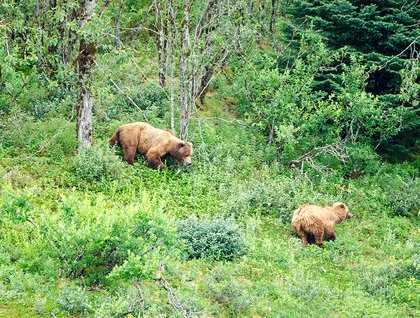Today’s adventures started early this morning when we picked up our National Park Ranger, Patrick Hair, and our Tlingit Cultural Interpreters, Bertha Franulovich and Archie Brown III from park headquarters in Gustavus. This spectacular place is a national gem of scenic beauty with massive mountain ranges, nature’s classroom on glacial succession and a place containing an abundance of wildlife for all people to share.
Our first stop was South Marble Island where the Steller sea lions were safely hauled out on a series of small rocks exposed by a glacier around 1845. These protected rocks are also home to a myriad of sea birds like the popular tufted and horned puffins. Our next wildlife sighting was just up the bay in Tidal Inlet and was what many of the guests traveled to Alaska to see - coastal brown bears. This was an extraordinary experience because we witnessed what appeared to be a boar pursuing a sow for mating purposes and a third smaller bear nearby that seemed to be nervously in the wrong place. We will never know what transpired between these bruins once they entered the forest.
Another highlight was the dozen mountain goats climbing the impossibly steep glacially scoured limestone at Gloomy Knob. A newfound respect for these animals as we experienced their amazing agility clamored up the vertical walls to graze in the meager patches of vegetation that comprise their exposed world.
55 miles up the bay from our morning departure at Bartlett Cove, we arrived at Margerie and Grand Pacific Glaciers to witness the mechanism that created this unique park over the past two hundred plus years. Just as we were pulling away from Margerie Glacier, we were treated to a large calving of ice from this tidewater glacier into Tarr Inlet. On our southbound journey, we encountered an unusually large raft of sea otters at Lone Island. We capped off our perfect day in Glacier Bay National Park with a scenic hike around Barlett Cove in a healthy old growth forest.







